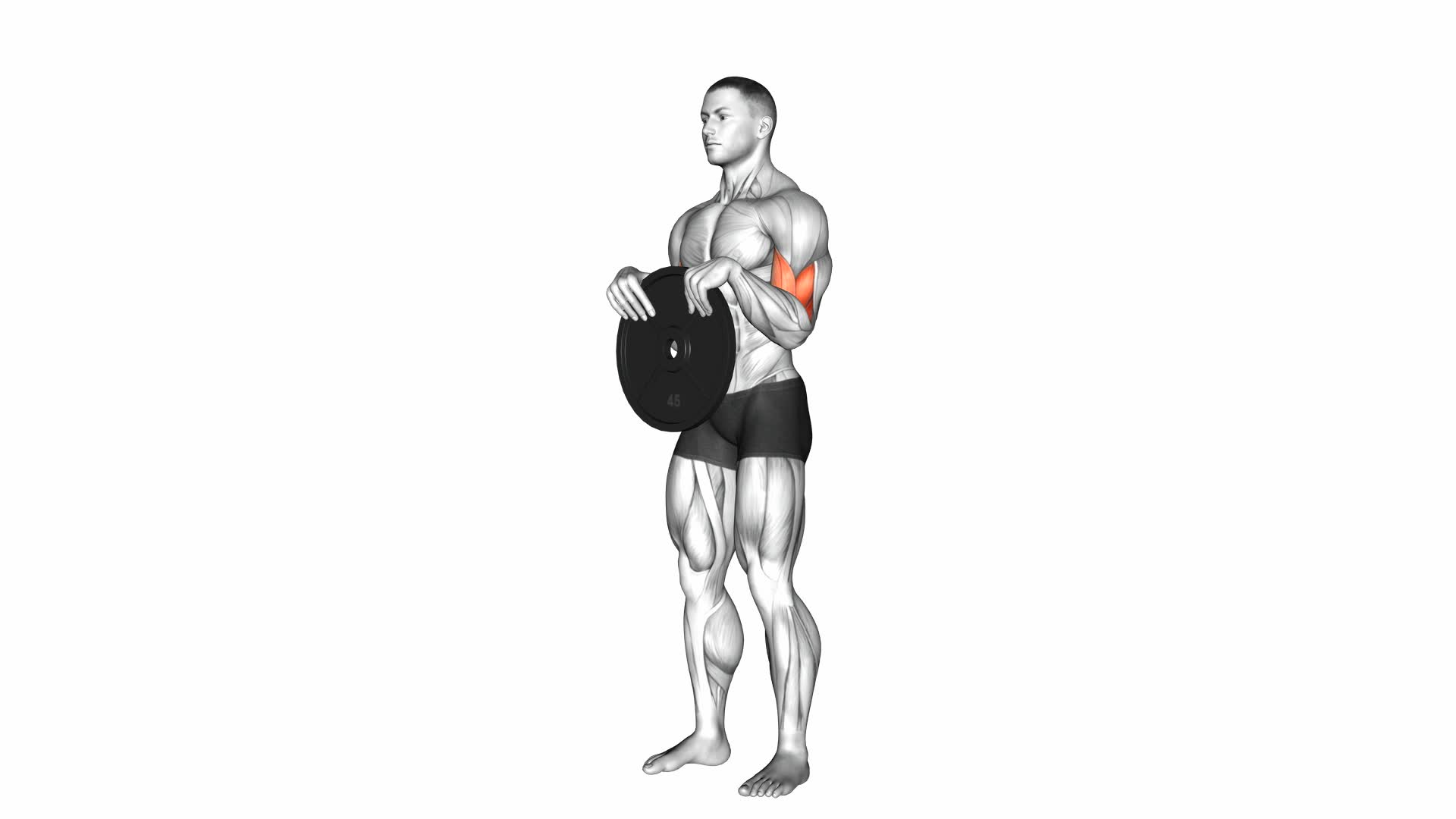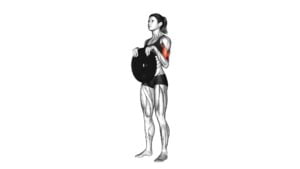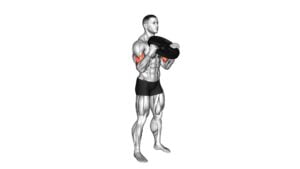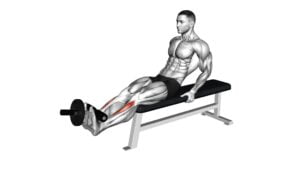Weighted Standing Curl – Video Exercise Guide & Tips

Ready to take your bicep workouts to the next level? Look no further than the Weighted Standing Curl.
Watch This Exercise Video
In this video exercise guide, we'll show you the proper form, variations for all fitness levels, and tips for maximizing results.
Whether you're a beginner or a seasoned lifter, this exercise will help you build strength and definition in your arms.
Get ready to feel the burn and achieve those gains!
Key Takeaways
- The weighted standing curl targets the bicep muscles specifically.
- It helps build strength and size in the biceps, leading to well-defined and sculpted arms.
- Engaging in this exercise enhances overall upper body aesthetics.
- Proper form and technique, along with variations and modifications, can help avoid injury and maximize results.
Benefits of the Weighted Standing Curl
To maximize your arm and bicep strength, incorporate the weighted standing curl into your workout routine. The weighted standing curl offers numerous benefits that can help you achieve your fitness goals effectively.
One of the main advantages of this exercise is that it targets the bicep muscles specifically, allowing you to build strength and size in this area. By performing the weighted standing curl, you can develop well-defined and sculpted arms.
Proper form and technique are crucial when performing the weighted standing curl to ensure maximum benefits and reduce the risk of injury. Start by standing with your feet shoulder-width apart and holding a dumbbell in each hand, palms facing forward. Keep your back straight and engage your core throughout the exercise.
Slowly curl the dumbbells towards your shoulders, making sure to keep your elbows stationary and your upper arms close to your body. Pause for a moment at the top of the movement, then slowly lower the weights back down to the starting position. Remember to maintain control and avoid swinging or using momentum to lift the weights.
Incorporating the weighted standing curl into your workout routine can lead to increased arm and bicep strength, improved muscle definition, and enhanced overall upper body aesthetics. By following proper form and technique, you can maximize the benefits of this exercise and achieve your desired results efficiently.
Proper Form and Technique for the Exercise
To ensure maximum benefits and reduce the risk of injury, it's important to maintain proper form and technique when performing the weighted standing curl exercise. This exercise primarily targets the biceps, helping to strengthen and tone the muscles in your upper arms. To perform the weighted standing curl correctly, you'll need a set of dumbbells or a barbell.
One common mistake people make when performing this exercise is using their back or shoulders to lift the weight instead of relying solely on their biceps. It's important to keep your upper arms stationary throughout the movement and only use your forearms to curl the weight up towards your shoulders. Another mistake is swinging the weight or using momentum to lift it. This not only reduces the effectiveness of the exercise but also puts unnecessary strain on your joints.
To avoid these mistakes, start by standing with your feet shoulder-width apart and holding the dumbbells or barbell with an underhand grip. Keep your elbows close to your sides and your back straight. Slowly curl the weight up towards your shoulders, making sure to contract your biceps at the top of the movement. Lower the weight back down in a controlled manner and repeat for the desired number of repetitions.
Variations and Modifications for All Fitness Levels
Explore different variations and modifications of the weighted standing curl exercise to accommodate all fitness levels. Whether you're a beginner looking to build strength or an advanced athlete seeking a challenge, there are progression options and equipment alternatives that can help you tailor this exercise to your specific needs.
Here are four variations and modifications to consider:
- Resistance Band Standing Curl: If you don't have access to dumbbells or barbells, using a resistance band can be a great alternative. Simply step on the band with both feet and hold the handles in each hand. Perform the curl motion as you'd with weights, feeling the resistance from the band.
- Single Arm Standing Curl: To increase the difficulty and target each arm individually, try performing the standing curl with just one arm at a time. This will require more stability and balance as you focus on each arm's strength.
- Hammer Curl: Instead of the traditional supinated grip, try using a neutral grip with your palms facing each other. This variation targets the brachialis muscle, which runs along the side of the upper arm and can help add thickness to your biceps.
- Seated Alternating Curl: If you prefer a seated position or need additional back support, try performing the standing curl while seated on a bench or chair. This modification can help stabilize your body and isolate the biceps even more.
Tips for Maximizing Results and Avoiding Injury
Continuing the discussion from variations and modifications, maximize your results and prevent injury with these helpful tips.
To ensure you get the most out of your weighted standing curl exercise, it's important to be aware of common mistakes and incorporate proper warm-up exercises.
One common mistake to avoid is using too much weight. While it may be tempting to lift heavy, using weights that are too heavy can compromise your form and increase the risk of injury. Start with a weight that challenges you, but still allows you to maintain proper technique throughout the exercise.
Another mistake to watch out for is swinging your body to generate momentum. This takes the focus away from your biceps and reduces the effectiveness of the exercise. Instead, keep your body stable and engage your core muscles to maintain control throughout the movement.
Before starting your weighted standing curl, it's crucial to warm up your muscles. This can be done through dynamic stretches or light cardio exercises such as jogging or jumping jacks. Warming up increases blood flow to your muscles, improves flexibility, and reduces the risk of injury.
By avoiding common mistakes and incorporating a proper warm-up, you can maximize your results and minimize the risk of injury during your weighted standing curl exercise.
Now, let's move on to the next section where we'll provide you with a sample workout routine that incorporates the weighted standing curl.
Sample Workout Routine Incorporating the Weighted Standing Curl
Maximize your results and strengthen your biceps with a sample workout routine that incorporates the weighted standing curl exercise. By following this routine, you can increase workout intensity and activate your bicep muscles effectively.
Here is a sample workout routine that includes the weighted standing curl:
- Warm-up: Begin your workout with a five-minute cardio warm-up to increase blood flow and prepare your muscles for exercise.
- Compound movements: Start with compound exercises such as squats or lunges to engage multiple muscle groups and maximize calorie burn.
- Weighted standing curl: Perform three sets of 10-12 reps of the weighted standing curl exercise. Use a weight that challenges you but still allows you to maintain proper form.
- Superset with tricep exercises: After each set of weighted standing curls, immediately perform a tricep exercise such as tricep dips or tricep pushdowns. This will add variety to your routine and work opposing muscle groups for balanced strength development.
Remember to rest for 60-90 seconds between sets to allow your muscles to recover. As you progress, gradually increase the weight and reps to continue challenging your biceps and promoting muscle growth.
Frequently Asked Questions
How Many Repetitions and Sets Should I Do for the Weighted Standing Curl?
When doing the weighted standing curl, it's important to follow repetition and set guidelines to get the most out of your workout.
To determine the appropriate number of repetitions and sets, consider your fitness goals and current fitness level. Generally, it's recommended to do 8-12 repetitions for muscle growth and strength.
Aim for 2-3 sets, resting for about 60 seconds between sets.
Make sure to maintain proper form and technique throughout the exercise to avoid injury and maximize results.
Can I Use Dumbbells Instead of a Barbell for the Weighted Standing Curl?
Yes, you can definitely use dumbbells instead of a barbell for the weighted standing curl. Using dumbbells as an alternative offers several benefits.
It allows for a greater range of motion, helps to improve muscle imbalance, and engages more stabilizer muscles. Additionally, using dumbbells allows you to work each arm independently, which can help to address any strength imbalances.
Is It Necessary to Warm up Before Performing the Weighted Standing Curl?
Before performing the weighted standing curl, it's important for you to warm up.
Warming up has several benefits, such as increasing blood flow to your muscles and preparing them for the exercise. It also helps to improve your range of motion and prevent injuries.
To perform the weighted standing curl with proper form and technique, make sure to stand tall, engage your core, and keep your elbows close to your body while curling the weight up towards your shoulders.
Can the Weighted Standing Curl Help With Building Bicep Strength and Size?
Incorporating weighted standing curls into your bicep workout can provide numerous benefits for building strength and size in your biceps.
This exercise specifically targets the bicep muscle group, allowing for isolated and focused training.
By using proper form and technique, you can maximize the results of your weighted standing curls.
It's important to maintain a straight back, engage your core, and avoid swinging the weights for optimal muscle activation.
Are There Any Alternative Exercises That Target the Same Muscles as the Weighted Standing Curl?
If you're looking for alternative exercises that target the same muscles as the weighted standing curl, there are a few options you can try.
One effective exercise is the hammer curl, which targets the biceps as well as the brachialis muscle.
Another option is the concentration curl, which isolates the biceps and allows for a deeper contraction.
Additionally, the preacher curl is a great exercise for targeting the biceps and building strength and size.
Conclusion
Incorporating the weighted standing curl into your workout routine can provide numerous benefits, such as strengthening your biceps and forearms. By following proper form and technique, you can maximize results and avoid potential injuries.
Whether you're a beginner or an advanced fitness enthusiast, there are variations and modifications available to suit your fitness level. Make sure to incorporate this exercise into a well-rounded workout routine for optimal results.

Author
Years ago, the spark of my life’s passion ignited in my mind the moment I stepped into the local gym for the first time. The inaugural bead of perspiration, the initial endeavor, the very first surge of endorphins, and a sense of pride that washed over me post-workout marked the beginning of my deep-seated interest in strength sports, fitness, and sports nutrition. This very curiosity blossomed rapidly into a profound fascination, propelling me to earn a Master’s degree in Physical Education from the Academy of Physical Education in Krakow, followed by a Sports Manager diploma from the Jagiellonian University. My journey of growth led me to gain more specialized qualifications, such as being a certified personal trainer with a focus on sports dietetics, a lifeguard, and an instructor for wellness and corrective gymnastics. Theoretical knowledge paired seamlessly with practical experience, reinforcing my belief that the transformation of individuals under my guidance was also a reflection of my personal growth. This belief holds true even today. Each day, I strive to push the boundaries and explore new realms. These realms gently elevate me to greater heights. The unique combination of passion for my field and the continuous quest for growth fuels my drive to break new ground.







